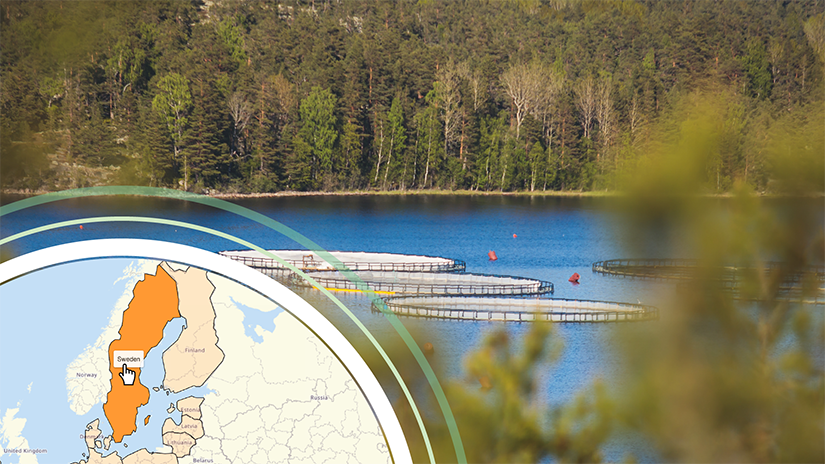Background information

Type of species farmed
Rainbow trout (Oncorhynchus mykiss), blue mussel (Mytilus edulis), oyster (several species), Arctic char (Salvelinus alpinus), Atlantic salmon (Salmo salar).
Source: 2024, STECF
Type of production method
According to Eurostat in 2022, 20% of Swedish production used off bottom method in sea and brackish water. A marginal percentage (0,002%) of production is farmed in ponds in sea and brackish water.
Source: 2025, EUMOFA
Sector’s size (production and consumption)
Source: 2024, EUMOFA; 2021, Official Statistics of Sweden
Trends (past and future)
Many aquaculture systems are currently monocultures but the production of organisms from different trophic levels in the same establishment is under development.
Source: MNSPA
Impact of aquaculture in the country’s economy, food market and labour market
- The aquaculture industry in Sweden has stagnated slightly in recent years in terms of productivity and profitability.
- The majority of aquaculture products produced in Sweden are used for human consumption. Rainbow trout, blue mussels and smokers account for the largest share of production based on weight. Aquaculture may also cover restocking or further rearing. Some species are also produced for their beneficial environmental characteristics, such as bivalve molluscs which, by filtering water, bind the nutrients that could otherwise lead to eutrophication.
Source: MNSPA
Challenges and opportunities
- Regulatory requirements resulting in complex permit granting processes and long processing times. The authorisation process for aquaculture is often lengthy, which is considered to be particularly problematic as the permits are normally valid for a maximum of 10 years.
- Suitable aquaculture sites, taking into account the environment and other activities, have not been identified in the municipality’s master plan to the desired extent.
- Difficulties in meeting existing environmental requirements and difficulties for companies to switch to more environmentally sustainable production.
- Increasing aquaculture production to meet local demand and decrease imports.
- Improving technical training and new regulatory frameworks knowledge.
- Lack of testing facilities to develop the aquaculture sector. For example, there are no facilities that can support the important step between research and innovation to commercial production.
- The market in domestic aquaculture products competes with cheaper imported raw materials produced using methods not allowed in Sweden.
- The aquatic environment in the Baltic Sea and in several other Swedish waters has several challenges such as litter, microplastics, changes in water temperature, eutrophication and environmental toxins.
- Climate change entails an increase in the frequency of extreme weather, which poses a threat to aquaculture carried out in natural waters. Climate change can also affect land-based crops in the form of increased need to be able to regulate the temperature of the water.
- Predators such as seals and birds can impair aquaculture productivity. Invasive species can also threaten the aquaculture industry, for example by spreading diseases and parasites.
- Aquaculture has the potential to focus more on innovation and new technological developments in both farming and feed development.
- The market has consumers who demand environmentally sustainable and organic products. Added value such as quality, environmentally friendly production and good animal health can increase the competitiveness of Swedish aquaculture products.
- In the Swedish market there is a demand for certified and sustainably fished fish as consumers show a growing interest in both locally produced and environmentally certified food. Different types of certification can allow differentiation and be an effective way to respond to a growing demand, so it can be important for aquaculture to be more widely certified. In order to allow for certification, traceability between production stages needs to be improved so that the origin can be verified with the necessary precision.
- Increasing interest in fish species that are not traditionally demanded and by reducing the impact of fishing on species with low stock status.
- Aquatic environments in Sweden offer conditions for different types of aquaculture with a wide coastline and many lakes and watercourses. In addition, in northern Sweden there are surpluses of green electricity through hydropower.
- Increasing the competitiveness, profitability and food production of the food supply chain.
- Increasing research and development in alternative feed materials to reduce environmental impact and improve sustainability.
Source: MNSPA
Multi-annual National Strategic Plans for the development of sustainable Aquaculture
Relevant Authorities
Applicable Legislation
Applicable Procedures
Check list how to start an aquaculture activity (Checklista Vattenbruk - verksamt.se)
Other Relevant Documents
- Joint strategy for the Swedish fishing and aquaculture 2021-2026 (Strategi för svenskt fiske och vattenbruk 2021–2026 – friska ekosystem och hållbart nyttjande (havochvatten.se)
- Work plan for the development of the Swedish aquaculture 2021-2026 (Handlingsplan för utveckling av svenskt vattenbruk 2021–2026 (havochvatten.se)
National associations and networks
- Matfiskodlarna (Matfiskodlarna - Vi verkar för matfiskodlarna i Sverige )
- De Recirkulerande vattenbrukarna (RECIRKFISK PO – De Recirkulerande Vattenbrukarna Sverige Ekonomisk Förening Producent Organisation )
- Svenskt vattenbruk och sjömat (Svenskt vattenbruk och sjömat (vattenbrukochsjomat.se))
Relevant Websites
Contact Details
Izabela Alias, Aquaculture Coordinator
